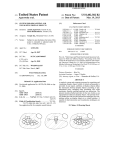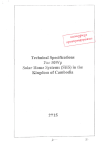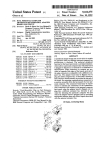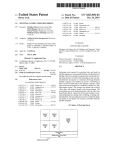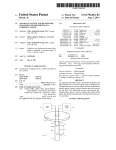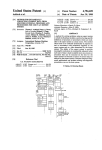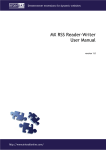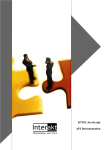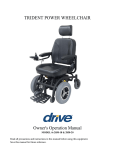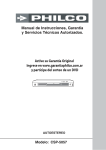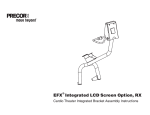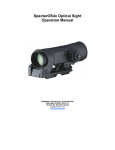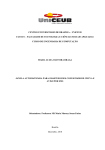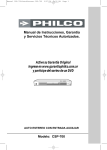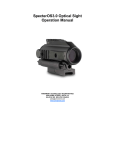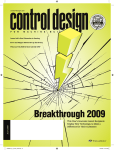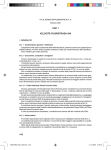Download System and method for determining target range and coordinating
Transcript
US007905046B2 (12) Ulllted States Patent (10) Patent N0.: Smith, III (54) (45) Date of Patent: SYSTEM AND METHOD FOR DETERMINING TARGET RANGE AND COORDINATING _ 4,777,352 A Mar. 15, 2011 7/1985 Moore ........................ .. 235/404 13/ (sihrlfeder BI e 7/1987 Morley et al. * 10/1988 Moore ........................ .. 235/404 Thomas D. Smith, III, Oklahoma Clty, 4,787,739 A * 11/1988 Gregory ..................... .. 356/403 OK (US) 4,923,402 A 5/1990 Marshall et al. 5,189,560 A * 2/1993 (73) Assignee: Thomas D. Smith, III, Oklahoma City, OK (Us) (*) Notice: _ (21) a 2 4,680,012 A _ Inventor: 4,531,052 A * a TEAM FIRE (75) US 7,905,046 B2 _ _ _ Edvvards et al. ............ .. 359/744 5,616,903 A * 4/1997 spnnger ~~~~~~~~~~~~~~~~~ " 235/414 6,322,365 B1 11/2001 Schechter et al. 6,636,296 B1 10/2003 Faulkner et al. _ Subject to any disclaimer, the term ofthls 6,681,512 B2* 7,421,816 B2 * Sammut ........................ .. patent is extended or adjusted under 35 2002/0139030 U_S_C_ 154(b) by 0 day, 2004/0016168 A1* 1/2004 Thomas et al. 2005/0213962 Al* 9/2005 Appl' NO‘: 12/043,875 A1* 1/2004 9/200g Conescu , 2005/0257414 A1 * 10/2002 Smith ............ Gordon ........ .. 42/122 42/122 . . . .. 42/122 42/122 396/502 ll/2005 ~Zaderey et al. ............... .. 42/122 (Continued) (22) Filed: (65) Mar. 6, 2008 OTHER PUBLICATIONS Prior Publication Data US 2009/0205239 A1 Aug 20’ 2009 Leupold, “Ranging System for the Tactical Milling Reticle4Oper ating Instructions”, Leupold & Stevens, Inc. Beaverton, OR, retrieved on Jun. 6, 2008 from http://WWW2.leupold.com/resources/ Related US. Application Data (60) Provisional application No. 61/029,203, ?led on Feb. 15, 2008. (51) d0Wnloads.htm. (Continued) Primary Examiner * Troy Chambers Assistant Examiner * Samir Abdosh Illt- Cl- F41G 1/00 (2006.01) (52) US. Cl. .............. .. 42/142; 42/144; 42/122; 42/130; 235/404; 89/41 '17; 89/41 '19; 89/204 (57) ABSTRACT A system and method for use of an enhanced aiming system (58) Field of Classi?cation Search ...................... .. None which includes a marker displayed at a ?rst position in an See application ?le for Complete Search history aiming scope, a user input of a start position and an ending References Cited position to measure a desired impact Zone, a calculator for determining a range to the target based on the known dimen (56) U.S. PATENT DOCUMENTS 3,392,450 A * 4,229,103 A * 4,263,719 A 4,336,018 A 4,352,665 A 4,380,437 A * 7/1968 Herteret a1. . 10/1980 4/1981 Hipp .......... .. Murdoch ...................... .. 33/297 6/1982 Marshall et al. sion of the impact Zone and the magni?cation value of the aiming scope, and a display in the aiming scope for showing an aiming point dot orbar to compensate for projectile drop at the calculated. range, and optionally for Windage and option any for movlng targethold'ovel 10/1982 Kimble etal. 4/ 1983 Yarborough, Jr. mama-bu: man-‘wean 24 Claims, 10 Drawing Sheets US 7,905,046 B2 Page 2 US. PATENT DOCUMENTS 2006/0005449 A1* 1/2006 Smith, III ..................... .. 42/122 2006/0010757 A1* 2007/0144052 A1* 1/2006 Smith, III 6/2007 Smith, III com/customeriservice/manuals/range?nders/20-5101imanual. pdf. 42/122 42/122 Leupold, “RXB-IV Digital Laser Range Finding Binoculars4Oper ating Instructions”, Leupold & Stevens, Inc. Beaverton, OR, 2007/0277421 A1* 12/2007 Perkins et a1. . 42/122 2008/0098640 A1* 5/2008 Sammut et a1. 42/122 retrieved on Jun. 6, 2008 from http://WWWZ.leupold.com/resources/ doWnloads.htm. Wikipedia, “Multiple Integrated Laser Engagement System 2008/0202011 A1* 8/2008 Shepherd .. 42/130 2009/0183417 A1* 7/2009 Smith, III 42/122 2009/0200376 A1* 8/2009 Peters et al. ................ .. 235/404 OTHER PUBLICATIONS Leupold, “Ranging System for the Mil Dot Reticle4Operating (MILES)”, retrieved on Jun. 6, 2008 from http://enwikipediaorg/ Wiki/MILES. Nikon, “Nikon Monarch LASER800 Instruction Manual”, Nikon USA, retrieved on Jun. 6, 2008 from http://support.nikontech.com. Clark, Col. Julius E. (US Army), “Army Joint Support Team”, Instructions”, Leupold & Stevens, Inc. Beaverton, OR, retrieved on Jun. 6, 2008 from http://WWWZ.leupold.com/resources/downloads. retrieved on Jun. 6, 2008 from sill-WWWarmy.mil/bcd/Conferences/ htrn. search for “military team ?re coordination training system”. Bushnell, “Elite 1500 User’s Manual”, Bushnell Outdoor Productgs, LeneXa, KS, retrieved on Jun. 6, 2008 from http://WWWbushnell. * cited by examiner 2005AJST%200verview%20COL%20Clark.ppt via Google.com US. Patent Mar. 15, 2011 Sheet 1 0f 10 lb US 7,905,046 B2 US. Patent Mar. 15, 2011 Sheet 2 0f 10 US 7,905,046 B2 US. Patent Mar. 15, 2011 Sheet 3 0f 10 US 7,905,046 B2 N .mm 3oz 2 .:0 EIXWEN 5:20 6Ixmmm5l 2 .5 US. Patent Mar. 15, 2011 Sheet 4 0f 10 US 7,905,046 B2 US. Patent Mar. 15, 2011 Sheet 5 0f 10 US 7,905,046 B2 Communicatiens orijaia mterfaca Neiwsrk 45 m Baliisiics Tabies Equation anciicr ; E \ Retictewiew Gamma ; Coeffichents L1 = use? gays 8‘ Cantmig -------------------- ; \ - , l gums Displd? 8‘ -------------------Cnmmi Lsgsc = HUD+LED or I LCD 0 0Transpagent , ‘ g Dispiaytn Scnpa 5 105111052 g1 Targati impact Zone Measuremants ___________________________________________ 2 ____________________________ ________________________ 200m Pssitinn Encoder andlor 200m Servo 10g; US. Patent Mar. 15, 2011 Sheet 6 0f 10 US 7,905,046 B2 cw, 5A8£EnLm6wx5E:m wwe6Q5E63E$a5m3d2s:3a0?“gtemn o?mh :0ma9wDEE32au8gt:5mcw3“uE? 0%; m howcwe»mumam .5Egs.0 FEEopea‘f1.5“w ?o?“anmnW5%uEceamrwy?,p 69.3%$95? .yum. >.h,o 310/3 90mm:m2$am3:5a 2m6g3?uaEnv“ 5%“my@2EQE7282 an m m m5 L :s n:u 1 mm US. Patent Mar. 15, 2011 Sheet 8 0f 10 US 7,905,046 B2 0&55Q5m.m,25w,: m$503I3M3.m?»w,z%mE?owaugsmGuz“mauw :m.u,\3gs? E3‘anmag2mg053um.Ag ME?mg25u.o?g .03U3550$3%»? . US. Patent lL I““mwamzw 5;; MM Mar. 15, 2011 mwucgzm 30m mamBEE3 Sheet 9 0f 10 US 7,905,046 B2 umcwz QE Ew 55. @“5SE Q 35m HwzgEoa ?u 45E9m50a2 WM @530 Exams “ma g. l1uw0i.aonmd§e pun-I.-u-n-u-u-u-npu-‘mum-.-mum-apm-uuq-u-mu-unmm 00E N. US. Patent Mar. 15, 2011 Sheet 10 0f 10 US 7,905,046 B2 m .mm Xmw cnm m9Q9,m3.03“6w2ig% aEgasEa?l“. wmgnztux,f US 7,905,046 B2 1 2 SYSTEM AND METHOD FOR DETERMINING TARGET RANGE AND COORDINATING TEAM FIRE mixtures in each shell and the volume variation by manufac ture, and they often resort to many idiocyncratic variations such as polishing their projectiles to ensure uniformity in CROSS-REFERENCE TO RELATED APPLICATIONS To address a very broad range of shooting applications, from small game to large game, short range to long range, projectile shape and Wind resistance. from civilian to military, industry has responded by develop ing approximately 1500 different calibers, bullet shapes, and This application claims bene?t of the ?ling date of provi sional patent application 61/029,203, ?led on Feb. 15, 2008, by Thomas D. Smith, III. cartridge designs. Because a projectile Will drop a signi?cant amount during such a long range trajectory, range estimation or measure ment remains an important task or skill of the shooter. Fur FEDERALLY SPONSORED RESEARCH AND DEVELOPMENT STATEMENT ther, selection of the proper “load” (e.g. caliber, bullet shape, bullet Weight, etc.) is also critical to achieving accurate shot placement. The tWo factors are interrelated and co-dependent trajectory shape and load characteristics. This invention Was not developed in conjunction With any To accurately measure range-to-target values in long range Federally sponsored contract. applications, many shooters utiliZe electronic means, such as a laser or radar-based range ?nder. In certain scenarios, hoW MICROFICHE APPENDIX ever, use of a range ?nding device Which emits a “scatter” of Not applicable. 20 such scatter can be detected, and the source pinpointed, by many military countermeasures. So, use of a laser range ?nder in a covert application on a battle?eld may result in INCORPORATION BY REFERENCE Issued US. Pat. Nos. 7,237,355; 7,222,452; 7,194,838; 7,069,684; 6,591,537; D456,057; and 6,357,158; and US. provisional patent application 61/029,203, ?led on Feb. 15, 2008, are hereby incorporated by reference in their entireties. 25 revealing the location of personnel. Some range measuring techniques using markings on reticles in scopes have been developed. For example, the Widely-used “Mil-Dot” reticle can be used to determine BACKGROUND OF THE INVENTION 30 1. Technical Field of the Invention ranges by performing certain calculations relative to the grati cule marks in the scope. But, these techniques remain math intensive, are extremely distracting to the essential psychop sysiological performance state required for a successful shot, and are not conducive to practice by shooters of limited math This application relates to displays Within scopes used for skills or education. Additionally, some research shoWs that a aiming ri?es, pistols, and other projectile delivery systems. It human’s math skills are diminished during times of intense stress, While other mental skills are increased, such as visual especially relates to determining range-to-target values, pro viding range and Windage-corrected aiming points, up-hill signal can be dangerous and contraindicated. For example, 35 and doWn-hill, altitude, barometric pressure, barrel tempera acuity. This shift of available mental faculties may tempo rarily disable a trained shooter from performing range calcu ture and the other various affects commonly grouped as exter lations at the very time he or she may need them most. nal ballistics and coordinating team ?ring activities. 2. Background of the Invention In a different, but related problem, training of users of scope-equipped guns remains di?icult because a coach is unable to see in real-time What the shooter is seeing. So, the Apparatuses for aiming of guns for sporting, competition, 40 coach is relegated to using diagrams and verbal descriptions to convey to the shooting student What the “sight picture” (e. g. the vieW of the target through the scope”) should look like, laW enforcement, and military purposes are Well knoWn and Wide spread. A very common aiming devices is knoWn as a “scope”, Which may be mounted to a variety of guns and including any offsets (e.g. “holds” for bullet drop, Windage, Weapons, including but not limited to ri?es and pistols. Some scopes include a ?xed magni?cation, or a variable magni? 45 In a similar application, teams of shooters, such as military sniper teams and hostage rescue teams, often are required to cation (Zoom) feature. HoWever, due to certain forces on projectiles While in ?ight coordinate and assign targets. Coordination and command is after the gun or Weapon system has shot or launched the usually performed by a centraliZed authority, but again, the projectile, aiming and predicting accurately the point of impact of a projectile is more dif?cult than just determining a straight “line of sight” from the muZZle of the gun to a target. Projectiles are diverted from straight ?ight by a number of factors, including but not limited to, Wind resistance, cross 50 critical, sometimes life-or-death, decisions based upon these Therefore, there exists a need in the art for a means to 55 Beginning shooters do not recogniZe the problem, but ing your eyes off the target once the target is acquired. There 60 animals or critical situations, such as hostage rescue team snipers, and for long range missions, such as military snipers. In these situations, variations in altitude, humidity, baromet ric pressure, cartridge chemicals, Weight of projectile, and shape of projectile have considerable effect. Many competi tive long range shooters, for example, “reload” their oWn shells to ensure uniformity of the chemical and hydration provide quick and accurate range determinations When using a scope-equipped gun or Weapon Without relying upon math ematical or computational skills of the user. Speci?cally expert shooters understand the essential nature of never tak vector according to an average or mean cross Wind speed. advanced and precision shooters, hoWever, agree that such a simpli?cation is unreliable for humane harvest of sentient central authority is unable to actually see What the team members can see via their scopes. So, the central authority must rely upon descriptions from the team members to make descriptions. Wind vectors, and gravity. As such, ballistic paths Within the Earth’s atmosphere are often modeled simply as pseudo parabolic vertical paths having a constant horizontal offset etc.). further exists a need in the art to share visual information from scopes of members shooting teams and groups to alloW for improved training, coordination, and command. SUMMARY OF THE INVENTION 65 A system and method for use of an enhanced aiming sys tem Which includes a marker displayed at a ?rst position in an US 7,905,046 B2 3 4 aiming scope, a user input of a start position and an ending position to measure a desired impact zone, a calculator for determining a range to the target based on the knoWn dimen 13 and the erector lens element 15, typically at a site consid ered to be a front focal plane of the optical system Within the housing. The reticle 16 contains ?ne etched lines or hairline sion of the impact zone and the magni?cation value of the aiming scope, and a display in the aiming scope for shoWing an aiming point dot or bar to compensate for projectile drop at the calculated range, and optionally for Windage and option indicia comprising a center vertical hairline 19 and a center horizontal hairline 20, Which orthogonally orperpendicularly intersect at a center point 26. The reticle further de?nes ?rst, second, third and fourth horizontal range and aiming marker hairlines 21, 22, 23 and 24 (or other designs as may be ally for moving target hold-over. appropriate to speci?c applications) respectively intersecting BRIEF DESCRIPTION OF THE DRAWINGS the vertical hairline beloW the center point 26 and vertically spaced apart and of preferably sequentially increasing length. The ?gures presented herein When taken in conjunction Each such range and aiming marker hairline 21, 22, 23, and 24 is bisected by the center vertical hairline 19, in the present With the disclosure form a complete description of the inven tion. FIGS. 1a and 1b are schematic illustrations of the internal components of a variable poWer telescopic sight for a gun. FIG. 10 is a side elevation vieW of a telescopic sight embodying the invention mounted upon a gun of the type manner as necessary to account to the vertical component of commonly used for hunting, target shooting and related prac reticle into the sighting system by other means, chie?y elec tices. FIG. 1d provides an illustration of an example control panel for a clickable scroll Wheel. design in a horizontal manner but potentially in an angled Wind drift, etc.). We must also note that it is feasible to present a virtual 20 alters the functionality of the present invention; therefore, any means of generating aiming points that achieves the same goal as that described herein is fundamentally identical in FIG. 2 illustrates one available embodiment of a head-up display type of subassembly for optically overlaying the invention’s aiming point and text onto the image of a reticle nature and is also claimed. 25 and target in a scope. FIG. 3 depicts one possible scope housing With an addi bars beloW the main crosshair intersection corresponding to bullet drops at given ranges, other reticles, such as but not 30 FIG. 5 provides example illustrations of usage of the inven limited to a MIL-DOT reticle, can be used With the present invention. Integrated Display tion in a ri?escope to hunt an animal. FIGS. 6a and 6b shoW logical processes and methods of use FIGS. 1a and 1b illustrate schematically the integration of according to the present invention. FIG. 7 illustrates coordinated elements for team usage of the invention in several enhanced embodiments. FIGS. 8a and 8b shoW enhanced aiming indicia based on grouping criteria from a bench sighting-in session. 35 DETAILED DESCRIPTION OF THE INVENTION 40 a display unit 100 in the optical chain, and optionally a cam era 101. In one embodiment, the display unit 100 comprises a dot matrix light emitting diode (LED), plasma, or liquid crys tal (LCD) or other suitable electronic display mounted sub stantially parallel With the optical axis or line-of-sight 18 of the assembly, and a partially re?ective (diagonal dotted line) lens is positioned at an angle such as a 45 degree angle to the optical axis, so as to alloW the image of the target to pass through to the eyepiece, While also transparently superimpos For the reader’s conveniences, issued US. Pat. Nos. 7,237, ing a re?ection of the display onto the target. Such a display sub-assembly is shoWn in more detail in FIG. 2, in Which the 355; 7,222,452; 7,194,838; 7,069,684; 6,591,537; D456,057; and 6,357,158 provide a great deal of background informa tion regarding ri?escopes and use of my other ri?escope inventions. The present invention is preferably realized in It should also be noted, that although a preferred embodi ment of the invention utilizes a set of subtending range marker tional portion for receiving the display unit. FIG. 4 provides a functional block diagram of the inven tion. tronically, and that the absence of a physical reticle in no Way 45 display panel 21 is positioned at an angle to the partially re?ective lense (20), and is provided With roW and column conjunction With my previous ri?escope inventions, but may pixel driver signals in order to produce graphic images (dots, be realized separately, as Well. lines, etc.) and text. This embodiment option resembles a miniaturized heads -up display (HUD), such as the larger units provided in aircraft and automobiles. In some arrangements, the display may be displayed upside doWn and/or mirror reversed in order to compensate for similar rotations and ?ips in the image of the target due to optical characteristics of a Turning to FIGS. la-lc, a telescopic sight 10, embodying this invention is shoWn attached by a suitable mount 35 to a 50 gun 12. The sight 10 is formed by a tubular housing 11 containing a forWardly positioned objective lens element 13, a rearWardly positioned ocular or eyepiece lens element 14, given scope design. an intervening erector lens element 15, and a reticle 16 dis posed betWeen the objective lens element 13 and the erector 55 lens element 15. In the case of vari-focal or zoom scopes, a FIG. 3 shoWs a perspective vieW of a scope body improved to house (30) the display unit 100 in a portion of it. In actual positionally adjustable magnifying lens 17 is associated With practice, the sub-housing portion Which receives the display the erector lens element 15. The exterior of the housing 11 unit can be of any suitable shape, but is shoWn as a cylindrical may be equipped With rotationally moveable features 36 for adjusting focus, parallax, magni?cation ratio, Windage and elevation. Each of the various lens elements may be single lenses or combinations of lenses, either aligned in proximity or glued together or a combination of these compositions. The reticle 16 is a circular, planar or ?at transparent panel or disk mounted Within the housing 11 in perpendicular rela tionship to the optical axis or line-of-sight 18 through the scope, and is positioned betWeen the objective lens element 60 portion to match the illustration of the circular display example of FIG. 2. In an alternate embodiment, the display may be a partially transparent disc, such as an LCD disc, Which is ?tted into the optical chain substantially perpendicular to the optical axis. This embodiment alloWs the shape of a traditional scope 65 housing to remain unchanged, but may have optical disad vantages depending on the optical transmission characteris tics of the disc. US 7,905,046 B2 6 5 Display Control Unit In the next step (c), the user operates the user inputs (1051) and (1052), such as depressing and clicking a scroll Wheel, A display control unit 1 05 is illustrated as being mounted to the side, or Within the stock of, the gun 12 to Which the scope 10 is mounted, as shoWn in FIG. 10. In alternative embodi then releasing the scroll Wheel, folloWed by rotating the scroll Wheel to move the dot to the opposite edge (54') of the desired impact Zone. In this example, the user has scrolled doWn to the ments, this control unit may be integrated into the scope itself, or mounted at other locations, such as the handguard, fore stock, or buttstock. FIG. 1d provides more details of the control unit 105, bottom of the IZ. If the user desires, the measurement can be made left to right, right to left, or bottom to top, instead of top to bottom, as Well. Which houses the control logic and/or microprocessor, and provides one or more user-operable input means, such as a When the dot is located at the opposite edge of the impact Zone, the user terminates the input by clicking again, pressing scroll-and-click Wheel 1051, set of buttons (up, doWn, next, previous, enter, etc.) 1052, or both. In the position shoWn on the ri?e of FIG. 10, a user’ s trigger ?nger can easily and safely reach the inputs 1051 and 1052 Without repositioning the hand 1053 on the ri?e grip, and Without accidental trigger an enter key, or similar user input. The control logic then (d) looks up the dimensions of the target’s impact Zone (42), reads the current Zoom setting from the encoder, and calcu lates the range to the target. Such a calculation, given the information from these components of the invention, can be operation. accomplished in several manners, all of Which are Within the skill of the art to implement in programming or logic. A Wire or cable interconnect 1050 provides electrical sig nals to and from the scope to drive the pixels of the display, read the position of the Zoom ring, and optional drive a servo motor to set the position of the Zoom ring. FIG. 4 shoWs a block diagram of the functions of the control unit, the display unit, and an optional camera 101. Logical circuitry, a programmed microprocessor, or a com bination of circuitry, processor and programs 41 are provided With a set of target impact Zone (IZ) measurements 42. For example, the (IZ) measurements may be sorted and catego Next, the control logic illuminates an aiming point dot in the display such that it Will correspond to the proper position 20 range. At this point, the user can raise or loWer the ri?e to place the 25 30 Once the Wind values are input, the control logic then The user input keys and scroll Wheel 1051 and 1052, and a calculates the amount of horiZontal drift or offset, and moves 35 Finally, the user moves the ri?e (or other gun) to position the aiming point dot Within the impact Zone of the target (51), Optional enhanced embodiments include storage of one or 40 ity (WiFi) or military Wireless JDAM interface. More details of the operations and logical features of the control unit Will be set forth in the folloWing paragraphs. Method of Use for Range Finding Turning to FIG. 5a, it Will be useful to the reader to under stand the basic method of use and user interface prior to 50 First, in step (a), the user positions the ri?e, pistol, or gun such that the target (51) is vieWable someWhere in the scope (50). In this idle mode, the re?ected display shoWs (56) that Windage Range Variance Bar According to an optional aspect of the present invention, 55 When the user supplies a range of Wind values, such as right 7 varying to 10 mph, a bar is shoW in the reticle display extend ing from the minimum Wind hold point to the maximum Wind hold point, as shoWn in FIG. 5a, steps (e) and (f). Multiple Impact Zones Per Target Type 60 such that the target appears (510 larger in the reticle. Further, the user positions the ri?e and scope such that the current dot position (54) lies on a ?rst edge of the desired impact Zone of the target, such as the top or left edge of the impact Zone. In this example, the user has positioned the ri?e such that the dot and main crosshairs are positioned at the top of the shoulder of the animal to be taken. the users eyesight off of the target. In sum, these advantages alloW for quick and accurate placement of shots at very long ranges. is positioned anyWhere in the reticle, preferably on the main crosshairs (52,53) or on a subtending range marker bar (55). In the next step (b), the user manually sets the desired magni?cation level using the Zoom ring on the scope. This illustration shoWs that the user has increased magni?cation This manner of usage of the invention alloWs very quick and accurate range estimates and hold point (e.g. aiming point) determinations Without the need for complex mental mathematics, Without the need for removing the hands from the normal shooting positions on the ri?e, and Without taking describing the logical processes of the invention. In this ?g the range to the target is not yet set, nor is the Wind correction value set yet. And, an illuminated dot (54), such as a red dot, and takes the shot. In alternate methods of use, the user can input the Wind values in advance of acquiring a target, such that fully com pensated aiming points can be realiZed Within l-2 seconds to complete steps (a)-(e). 45 ure, a perspective of a user/ shooter looking through the scope (50) according to the invention is shoWn in a step-by-step manner. the aiming point accordingly to compensate for Windage (54"'), and preferably updates the text display to shoW the Wind value (56"). more ballistics tables or equations (43), as Well as a commu nications or data netWork interface, such as a Wireless Fidel Which the user enters or adjusts a Wind value, such as a single value or range of values. In this example, the user has input a Wind range of 7 to 10 mph. from the right. Again, scrolling and/or key inputs may be used to select or adjust these values. types and Zones. Zoom ring position encoder are read by the logic 41, and their positions used in the logical processes to illuminate dots, bars, and text on the display (100). aiming point dot in the impact Zone, adjust manually for Windage, and take the shot. HoWever, according to a preferred embodiment of the invention, the user may also proceed to the next step (e) in riZed by type of target (e. g. White tail deer, black bear), and by Zone Within each target type (e. g. head, chest, etc.). For example, a target Zone height for a Whitetail deer’s chest might be 18'', and Width ofthe chest Zone may be 15". The IZ measurements (42) can hold dimensions for a feW target types and Zones, or it can hold many dimensions for many target or range marker bar (54") on the reticle to compensate for bullet drop at the calculated and displayed range. And, pref erably, the text display is updated (56') to shoW the calculated According to an optional aspect of the present invention, the stored impact Zone measurements (42) include multiple impact Zones per target type. For example, an alternative impact Zone for a head shot for the same target type shoWn in FIG. 5 can be entered, and the user has selected a target type 65 of White tail deer. By entering head instead of chest as the impact Zone for the White tail deer, the control logic looks up a second impact Zone dimension to calculate the range. Oth US 7,905,046 B2 7 8 erWise, the steps remain the same as those described in con Turning to FIG. 6a, and folloWing a similar example as that shoWn in FIG. 5a, the user initially locates the target in the scope 60, optionally sets a Zoom level 61, and places the dot junction With FIG. 5, except substituting the head Zone for the chest Zone dimension. (at its default location) on the ?rst edge of the desired impact Display Colors for Mental Cues According to an optional aspect of the present invention, a Zone 61. The ?rst edge can be a top, bottom, left side, or right side of the impact Zone. The default dot location can be the center of the crosshairs or another point in the reticle. At this color display is utiliZed to convey an extra level of informa tion to the user in a quick-to-comprehend format. For idle stage of the logic 601, the display 1000 shoWs no setting for the range or the Windage, and optionally may be shoWing example, the dots in steps (a) through (c) of FIG. 5 may be shoWn as red dots to indicate the aiming point is not adjusted for range or Windage. Then, When the aiming point dot has a selected breed/species and/or impact Zone 62. Next, the user clicks, presses a key, makes a partial draW on the computer, or operates another suitable control 63 in order to initiate the automatic range determining process of the been adjusted for range, but not for Windage, the aiming point dot may be shoWn in yelloW (step d), at Which point the shooter may manually adjust for Windage and take a shot. Finally, as Windage is factored into the aiming point adjust logic. Responsive to receiving this control input, the logic ment, the aiming point dot may be shoWn as green to indicate the aiming point is fully compensated. In other embodiments, ?ashing and steady states of the dot may be utiliZed to convey similar status information. Similarly, the text may be shoWn in colors, such as red for text indicating in input parameter has not been entered or calculated, and green for text indicating a parameter Which has been input or calculated. 20 logic. The logic then uses the magni?cation level 604, the impact Incremental and Accelerating Scrolling Action To ease and speed the completion of the impact Zone dimensions input from the user, the control logic may accel 25 erate the rate of movement of the dot after an initial scrolling rate, or it may advance or jump the dot by increments to alloW Zone tables 605, and calculates the range to the target by the apparent siZe in the reticle as marked by the user 606. Next, an estimation of the vertical drop of the selected bullet and load type is retrieved 607 from ballistics tables 43, or calculated from ballistics equations using conventional ballistics esti course positioning of the dot ?rst folloWed by ?ne positioning last. monitors the scroll Wheel position, movement keys, or other movement controls, and updates 602 the display 64 to shoW the scrolled or moved position of the dot in the reticle, until the user has positioned the dot on an opposite edge of the impact Zone. At this point, the user terminates the marking of the impact Zone by clicking, pres sing a key, or operating some other suitable control 65, Which is received 603 by the control mation means. 30 NoW, the display 100 is updated 66 by the logic 608 to shoW Circular Markers for Impact Zone in Range Finding In an optional embodiment, instead of scrolling and mov the dot at an aiming point in the reticle Which compensates for ing a dot to mark the edges of an impact Zone, circles, squares, to shoW the range value estimation. At this point, the user can decide 67 to take an early shot by or other shapes can be shoWn to alloW the user to quickly encompass or encircle the impact Zone. bullet drop at the determined range, and the display is updated 35 Automatic Zoom Setting for TDS Trifactor Calibration of be taken 68. HoWever, if the shooter Wishes, he may continue to re?ne Reticle to Load According to an optional aspect of the present invention, a the aiming point by inputting 620 Wind value (e. g. 8 mph from TDS Trifactor ReticleTM such as those described in my US. Pat. Nos. 7,237,355; 7,222,452; 7,194,838; 7,069,684; 6,591, 537; D456,057; and 6,357,158 is provided in the scope. In 40 such a case, or even With other reticles, a servo motor under user has input a range of Wind values, a Wind Variance Bar 45 In particular With the TDS Trifactor ReticleTM, the “factor” of the particular load can be used to automatically select a Zoom level by the servo motor Which Will scale the subtending range marker bars to the exact ballistics of the load being used. With other reticles, the optional ballistics tables or equa 50 Alternatively, if the target has moved, conditions have 55 changed, etc., the user can return to any previous state in the process 623/634 to revise conditions, and to get corrections to the aiming point provided in the reticle. Hold-over Estimation and Compensation alloWing the user to manually adjust the Zoom ring if desired. Logical Processes In a similar manner as described relative to the Windage 60 as softWare, ?rmWare, custom circuitry, or a combination of softWare, ?rmWare and circuitry. It is Within the skill of those in the art to adapt the folloWing logical process descriptions With suitable design methodologies. For these reasons, the operations as illustrated by FIGS. 6a and 6b provide at least one example embodiment of the invention Which may be reduced be realiZed. vided by the user. The aiming point dot, and optionally the WVB, are positioned on the display appropriately 632. The user can noW move 621 the gun to place the dot and/or that Zoom level (eg 12><, 9.5x, etc.) in the display 100, The logical processes of the invention may be implemented (WVB) is calculated 631 to stretch in the display from the minimum Wind value to the maximum Wind value, Which effectively indicates to the shooter the likely area of bullet impact at the determined range in the Wind conditions pro the WVB in the impact Zone of the target, and the optionally take the shot 622/624. tions 43 may be used to select a Zoom level in order to scale part or all of the reticle’s markings appropriately to the bal listics of the actual load being shot. Alternatively, an embodiment is available in Which the logic 41 determines an appropriate Zoom level, and displays the right) or range of Wind values (eg variable 7 to 10 mph from the right), as shoWn in FIG. 6b. The logic receives this input 630, and calculates a horizontal Windage offset to cor rect the aiming point display for Windage. Optionally, if the the control 44 of the control logic may be provided to auto matically position the Zoom ring on the scope, as illustrated in FIG. 4. manually adjusting the aiming point to the left or right of the aiming point dot to compensate for Windage, and the shot can adjustment, the aiming point can be compensated for a mov ing target based on user input for the direction and rate of movement. For example, the user may input a rate of move ment of 3 mph to the left. This Would be added to the Windage value if the Wind and movement are in the same direction, and 65 subtracted from the Windage value if the Wind and movement are in opposite direction. Then, When the aiming point and/or WVB are plotted on the display, the aiming point Will include US 7,905,046 B2 10 cess may be onboard the gun, such as being integrated into the display control logic, or may be remote to the gun intercon nected via the netWork. The results of the recognition and/or the proper amount of hold-over to allow the user to place the aiming point dot on the desired impact Zone and take the shot, rather than to have to place the aiming point ahead of the moving target to compensate for movement. classi?cation process may be provided in the reticle by trans mitting the results via the netWork to the control logic, and Reticle-vieW Camera As shoWn in FIGS. 1a and 1b, in at least one embodiment of the invention, an electronic camera is provided in the scope updating the display appropriately. assembly to alloW a vieW of the display, reticle, and target, manner of usage and logical processes, an image is doWn Side-by-Side Image Display. In yet a further enhanced from the same perspective as the shooter/user. In the example embodiments of these ?gures, the same partially re?ective loaded to the display via the netWork, and is displayed coin cidentally in the reticle With the real life vieW of the target. screen (20 of FIG. 2) is utiliZed to provide a composite image Such a doWnloaded image can be used to make a side-by-side to a camera 101. The camera image data is then transmitted to a remote display via a communications or data netWork (45 of comparison by the user of the currently vieWed target With a previously-taken image or photo of a target similar to that FIG. 4) for additional use, as described in the folloWing Which the shooter is instructed or desiring to take. For example, during doe season, a neW shooter may be provided an image of a deer doe for reference in the reticle, Which can paragraphs. Team Operation V121 Camera and Remote Display Manipula tion The camera 101 and netWork interface 45 alloW for an additional level of enhanced operation and usage. A general arranged as shoWn in FIG. 7 alloW a coach or commander 74 to vieW the reticle images of a plurality of shooters 71 over a netWork 73. Each shooter’s reticle camera image is shoWn on 20 played in the reticle for real-time comparison by a sniper to face of a person being vieWed through the scope. one or more coach’s or commander’s consoles 75, and enhanced logical processes of the invention enable a group level of coordination, training, and cooperation not before available in individual ri?escopes. Training and Coaching. In a training or coaching scenario, 25 her reticle on his or her respective target 72. By being able to 30 then provide instructions on adjustments and repositioning, such as by verbal instructions (eg by radio or in person). Additionally, With enhancements to the logical processes of the present invention, the coach’s console is provided With animal. Such a Wounded animal may ?ee to a location, and such as big cats or bears, a Wounded animal may pose a safety threat to the hunter. control data is transferred from the console to the ri?e’s display control logic via the netWork. This coach’s mouse or joystick then controls an additional dot or pointer in the oWn coach’ s dot so that the coach may provide individualiZed instruction to each shooter. Fire Coordination. In the usage scenario of a multi-shooter operations, it is generally considered undesirable to merely Wounded enemy to continue to ?ght, or to lay in Wait “playing 40 dead” until friendly forces approach to detonate explosives. In laW enforcement shooting, such as in hostage situations, it is desirable to remove the hostage taker from the scenario in a manner Which does not alloW him or her to take further harmful action. Wounding, but not killing, a hostage taker 45 With the ?rst shot may result in the death or injury of the hostages, or further danger to laW enforcement of?cials, such as members of a tactical entry team. targets to each shooter, communicating changes in reticle placement, etc. HoWever, present day ri?e scopes provide no guidance Whether a particular round at a particular distance Will kill or 50 Wound the target. While many of the precision scopes Will provide aiming capabilities to deliver the round on the target, it is unknoWn to the shooter Whether or not the round at that distance Will possess characteristics su?icient to provide a is provided With a control means to take a “snapshot” of his or her reticle vieW, such as by double clicking the scroll Wheel. rapid death of the target. This snapshot of the user’ s reticle vieW can include a image of a target of question. When the image is received by the commander or coach, In military and laW enforcement shooting, a similar need arises to make a kill When taking a long range shot. In military Wound or maim an enemy soldier. Doing so may alloW the ?re team, the commander of the team operates the coach’s console 75 and uses the coach’s dots to assist in assigning Snapshots for Remote RevieW and Approval. In a further enhanced manner of usage and logical processes, the shooter mal at those distances. It is generally considered unsports manlike and inhumane to Wound, but not kill quickly, an may suffer. Or, in the case of some animals that “hunt back”, a pointing means, such as a mouse or joystick, for Which 35 display of the scope of each shooter, Which alloWs the coach to visually shoW the shooter Which target to use, Which range marker bar to use, and Where to position the reticle relative to the target. Each shooter is preferably provided With his or her Kill Zone Indication Based upon my experience in harvesting over 200 tons of Wild game of all siZes and types, I have determined experi mentally that even though a bullet may remain accurate (e. g. predictable path) at long distances, it may or may not still possess the capability of killing or “taking” the targeted ani the coach 74 can see hoW each shooter 71 has aligned his or actually see the reticle alignment, the coach or trainer can be compared in real time to the actual animal being vieWed through the scope. In a military or laW enforcement applica tion, and image of a sought enemy or fugitive can be dis 55 the commander or coach revieW the image and approve or I have experimented for many years With this concept, and have developed a neW science regarding determination of the ability of a round to kill the target. Such information is not disapprove taking the shot. For example, in a coaching sce contained in ballistics tables, only bullet ballistics coe?icient, nario, the user may take a snapshot of an animal he or she velocities at certain ranges, energy at certain ranges, drop at certain ranges, etc., are contained in ballistics tables. I have discovered that there are three important factors believes is a legal animal (age, species, gender, etc.) to take. If 60 the coach agrees, the coach can so indicate by positioning or moving the coach’s dot in the shooter’s reticle. Biometric Classi?cation of Target. In yet a further about a round in ?ight regarding its ability to kill or just Wound a target. First, the type of target must be considered. A large animal, such as a bear or elk, requires much more enhanced manner of usage and logical processes, the snap shot of the reticle image is received by a biometric recogni tion and/or classi?cation process, such as a facial recognition system. The biometric recognition and/or classi?cation pro 65 “killing poWer” than a smaller animal, such as a small dear or fox. Conventional thinking is to use larger caliber, larger charges to kill larger animals. US 7,905,046 B2 11 12 This conventional thinking Works for the loW end of the scale, but only to a certain degree. For example, a .223 caliber ri?e shooting a 165 grain bullet is su?icient to kill a coyote, limit to this combination of velocity and energy. For example, smaller rounds at higher velocities may penetrate completely through a certain target, leaving a clean hole through a tissue but Would not be a Wise choice for hunting bear. But, the same .223 ri?e, While accurate at say 600 yards, may not provide suf?cient killing poWer for even a coyote. So, if one Were hunting larger game, one might move up to much more poW such as a muscle or fatty area, and not killing the target animal. But, With different shot placement, or on a different animal, such a “clean through” shot may not occur, resulting in all of the bullet’ s impact being absorbed by the target, and resulting in greater trauma, leading to death of the target. erful charges, larger caliber bullets, and heavier bullets. But even these more poWer loads are not effect for killing game beyond certain ranges, even though the round itself is still My conclusion, based on my analysis of thousands of entries in ballistics tables and real-World experience shooting “accurate” (e.g. its position can be accurately predicted With a scope). So, my second factor that I have discovered is necessary to many game types With many loads and bullets, is that a provide “killing poWer” for a given prey or game type is the generally applicable rule that both accurately predicts the energy possessed by the round at the distance or range to the target. If a bullet does not possess enough kinetic energy at a given distance, it Will not cause enough trauma or injury to the game, and it Will not kill the animal. killing poWer of a round and is simple enough for a hunter, But, energy is not the only factor, I have discovered. For example, a large caliber, heavy bullet Will possess a good deal soldier, or laW enforcement of?cer to determine in conditions of tactical stress is a summation of the bullet’s energy and the bullet’ s velocity at the given target range must exceed a mini 20 of energy even at loWer velocities because energy is a function ofmass (e.g. E:mc2, Where E is energy, In is mass, and c is the constant speed of light). So, With this Well-knoWn relation ship, even a locomotive engine moving at just 3 mph. pos 25 In practice, I have found that the folloWing equation is sesses a great deal of energy, but if it bumps into a bear on the generally accurate for all 330 knoWn rounds of ammunition tracks, it Will not kill the bear, but instead Will cause the bear to simply move aWay (perhaps With a bruise). The same is true for large caliber, heavy bullets at long ranges Where the energy is still considerable, but the velocity is loWer. So, to discover the remaining characteristics of What it mum threshold for the game type. Further, for convenience, I have found that dividing game into 3 to 5 categories, from small and easy to kill to large and di?icult to kill, further improves the ability of the shooter under mental stress to make the kill poWer determination. for ri?es, Where KT is the target killing factor, v is the velocity 30 of the round in feet-per-second, e is the energy of the round in foot-pounds, and d is the distance of the bullet from the muZZle of the ri?e (typically in yards): takes to produce a kill With a single, accurately delivered round, I have applied the theory of energy maneuverability to the consideration of the bullet in ?ight. Energy maneuverabil ity is a complex theory Which explains hoW objects in ?ight 35 Where mag[a] is a function to take the unitless magnitude of the value a. obtain energy and velocity, maintain energy and/ or velocity, and lose energy and velocity. In short, energy maneuverabil Any bullet having a KT factor greater than 2200 found by ity can be described as a theory Which covers “hoW fast it adding the magnitudes (Without units) of the energy of the starts, and hoW fast it stops”. While energy maneuverability is a Well-knoWn theory, originated by Col. John Boyd, among modern ?ghter pilots, it is not knoWn Within hunting, preci 40 to kill an animal in one or more animal categories, for example. This alloWs for variations in bullet Weight, ballistic coe?icient, poWder charge, etc., to be considered Without sion shooting, sniper, and competitive shooting experts. It has, until my present discovery, remained purely a concept among aeronautical engineers, pilots, and combat aviation 45 instructors. expressly or explicitly requiring the shooter to refer to com plicated ballistics tables, make calculations in his or her head, or use even more complicated tables, all While under stress. In applying energy maneuverability to the problem of So, in one embodiment of the present invention, hypotheti determining Whether or not a bullet Will “take” or kill a particular target type, I have discovered that besides target bullet and the velocity of the bullet at a given range d is likely 50 type, predictable bullet position (e.g. knoWn drop), and suf cal target animals can be divided into 5 classes, as shoWn in Table 1. ?cient energy at a given range, a critical factor is velocity. If a large round impacts a large animal at a range Where the velocity is su?icient to provide penetration to the main body cavity, then a kill is likely. If, hoWever, a large round With lots of energy impacts large prey at sloWer velocities, the round may not penetrate the portion of the animal’s body, and may cause only super?cial or non-lethal trauma, such as light bruising to broken or shattered bones, to shalloW tissue and TABLE 1 Fxamnle KT Data Table 55 Target Class 60 organ trauma. Animal Size Example KTml-n I II III small small-medium medium varmints bobcat White tail deer 2200 3000 3400 IV V medium-large large mule dear elk, bear 4200 4500 But, I have discovered experimentally that it is not a simple matter of setting a minimum velocity and a minimum energy to determine a probably kill With a certain round. I have discovered that the tWo factors have a “trade-off’ relation ship, and that for some combinations, there may be an upper So, using common ballistics tables Which provide v(d) and 65 e(d), one can calculate a neW table for encoding into the neW system’s coef?cients (43), such as that shoWn for a hypotheti cal round in Table 2. US 7,905,046 B2 TABLE 2 Fxamnle KT Data Table KT > KTm-n for T-Class @ d = Round .308 .308 .308 .308 .308 130 130 130 130 130 gr. gr. gr. gr. gr. Target Class 100 200 300 500 700 800 I II III IV V Y Y Y Y Y Y Y Y Y Y Y Y Y Y N Y Y Y N N Y Y N N N Y N N N N . N N N N N ToWards the end of this exercise, the shooter has achieved a certain level of performance, some due to the equipment This table can be extended or modi?ed for any round, using either commonly available ballistic table information for pro duction ammunition, or using experimental information for custom ammunition. As such, the invention’s tables and coef ?cients (43) can contain table entries for a single type of (ammo, ri?e, scope, sling, rest, bipod, etc.), but some due to the shooter himself. According to this additional aspect of the present inven ammunition or for a Wide range of ammunition. To provide the user With a real-time indication of the like 1000 20 lihood of a one-shot, one-kill, the control processes (FIGS. 6a and 6b) for the reticle display (FIGS. 2, 5a and FIG. 5b) are tion, the user ?rst inputs a grouping criteria from a bench sighting-in session into the tables (43), Which are stored and saved for later use by the logic (41). For example, a user may enhanced to highlight a range marker bar or to providing an ?nd at 200 yds that he or she can hold a 3-inch diameter illuminated dot only When the entered target class is Within a range for Which KT is su?icient to kill the target animal. To set up the scope, the user must initialize the scope by grouping (e.g. all of his or her shots are placed Within a 3-inch circle at 200 yards). 25 So, using the entry controls (105), the shooter can enter a entering the intended target class, either by selecting a cat egory, or by scrolling through a list of available animal types, range (200 yds in this example) and a grouping siZe (3 inches). Then, When using the scope in the ?eld, the aiming and must enter the ammunition be used (if not defaulted to a single type of ammunition). Then, as the user engages the 30 range ?nding operations, the control logic further consults the KT table (or alternatively a formula), and updates the display example, +/—1.5 inches at 200 yards correlates to a 0.75 MOA appropriately. For example, a red-colored dot may be dis played When KTml-n is not met to dissuade the shooter from taking the shot, and a green-colored dot may be displayed accuracy, Which then can be plotted as a 0.75 MOA radius 35 When KTml-n is met to indicate an acceptable shot can be made. Or, a ?ashing dot may indicate When KTml-n is not met, a continuously illuminated dot may indicate When KTml-n is met. Likewise, other symbols may be useria dot for KTml-n being met, and an “X” or crossed-out circle for KTml-n not being met. dot (80) can optionally be replaced With or encompassed by a circle (81) of the appropriate siZe according to the user’s bench group criteria, as shoWn in FIG. 8(a). In the present circle around Where the aiming point is. At 100 yards, the circle Would represent a 1.5 inch diameter area on the target. At a range of 700 yards, the shot group circle (81) Would represent a 101/2 inch diameter circle of likely shot placement on the target 40 It is a further enhancement of the present invention to break shots into tWo types of kill shotsihead shots and chest or In this manner, the grouping circle Will appear larger for greater ranges, While giving the shooter a realistic under standing of his or her ability to place the shot. This is a signi?cant improvement, Where standard aiming dots and body shots. Head shots, obviously, generally represent crosshairs may lead a shooter to believe he or she can place a “smaller game” than the full body siZe of the target, unless the 45 particular game has a Well-armored head structure. Other Wise, if one is planning a head shot, and believes that he or she can meet the additional accuracy required to place a head shot (because most game have smaller heads than chests), the user can simply use a loWer category of game for the KT indicator. shot more accurately than practically possible for the shooter and the equipment. Alternatively, other shapes, such as a triangular shape (82) can be placed around the aiming point (80) to represent the 50 variation in crossWind values. This type of shape Would be very useful in gusty Wind conditions. With this enhanced aiming indicia based on the user’s practical performance, the user gets a more realistic idea of Bench Grouping Display According to another aspect of the present invention, the scope display and control logic (41) is enhanced to receive and store information regarding a particular shooter’s per sonal results in maintaining shot grouping, and then uses this information to shoW a likely region of impact When in the ?eld. 55 Whether he or she Will make the kill, so that the shot can be taken or aborted, as appropriate. CONCLUSION For example, prior to going hunting, most shooters Will take a ri?e With a scope and some ammunition to a shooting range to “sight it” their scope. This is done to adjust the scope for differences in ammunition, and for slight, but consider able changes in the mechanical combination of the ri?e and the scope. During sight in, the shooter Will aim and shoot at a target at a knoWn distance, usually 100 or 200 yards. When sighting in is completed, the shooter Will be able to maintain a certain grouping of shots at the selected distance, and the scope settings are recorded or saved as a “Zero”. 60 65 The foregoing examples are provided in order to illustrate the invention, but do not represent the scope and limits of the invention itself. It Will be recognized by those skilled in the art that alternative embodiments, manners of usage, and combi nations of optional features can be realiZed Without departing from the spirit and scope of the present invention. For this reason, the scope of the present invention should be deter mined by the following claims. US 7,905,046 B2 15 16 I claim: matching a ?rst set of predetermined ranges and a second set 1. A telescopic gun sight having an optical system com of predetermined ranges for all incremental aiming indicia so located upon the reticle. 8. The system according to claim 2 Wherein the ri?e com prises a ri?e stock and further comprising a keypad disposed in the ri?e stock, a connection from the keypad to a disk in the gun sight tubular housing, and the disk connected to a minute prising: a forward objective lens element; a rear eyepiece lens element; an intermediate erector lens element; said lens elements being aligned along an optical axis constituting a line of sight and protectively con?ned Within an elongated tubular housing adapted to be of angle grid comprising an electronically connected reticle displaying a lens imprinted With a set of ballistic indicia. 9. The system according to claim 1 Wherein the system securely a?ixed to an ordnance ?ring device; and a substantially transparent reticle betWeen said objective and erector lens elements, said reticle having tWo inter connected grids, a ?rst being a distance-measuring grid further comprises: means for inputting selected data for y-axis height of a target in inches; means for correcting for Wind drift; means for correcting for phenomena associated With gyro scopic forces on a gyroscopically stabiliZed bullet constructed of an electri?ed grid Which illuminates a selected intersection to produce an aiming dot, Which aiming dot grid is not visible to a shooter except for the aiming dot and Which is interconnected to a second including YaW of Repose and Magnus effects; reticle having ballistic aiming indicia thereon, said indi cia comprising a center vertical straight hairline and a 20 center horiZontal straight hairline, said center vertical and center horiZontal hairlines intersecting substantially perpendicularly, and a series of primary range-marker indicia disposed beloW said center horiZontal hairline, the vertical spacing of said primary range-marker indi Wherein said inputting and correcting is performed in accordance With Mental Ballistics Calculator calcula tions; and further comprising: 25 means for compensating for ordnance ?ring device barrel temperature; and means for changing a poWer ring to equate the energy of maneuverability of a speci?c one of 335 cartridges to be 30 Wherein the disk computes an intersection of the grid, cia beloW said center horiZontal hairline being non evenly spaced and proportional to drop of said ordnance at selectively increased target ranges dependent upon the substantially parabolic ?ight of real projectiles ?red in earth’s gravitational ?eld, Wherein the spacing of said shot by the ordnance ?ring device; Wherein changing conditions are re?ected as an aiming range-marker indicia beloW said horiZontal center hair dot on the connected reticle Which displays the lens line is determined at the gun sight’ s highest poWer at one imprinted With a set of ballistic indicia. or tWo hairlines or one and tWo and three hairlines or one and tWo and three and four hairlines or one and tWo and three and four and at least one additional hairlines in a 10. A telescopic gun sight having an optical system com 35 a rear eyepiece lens element; an intermediate erector lens element; or tWo hairlines or one and tWo and three hairlines or one 40 range of —8 to —103 inches of subtention at 100 yards, respectively. 2. The system according to claim 1 Wherein the ordnance ?ring device is a ri?e for shooting a bullet at a target. prising: a forWard objective lens element; range of —1.2 to —18 inches of subtention at 100 yards, respectively, and at the gun sight’s loWest poWer at one and tWo and three and four hairlines or one and tWo and three and four and at least one additional hairlines in a means for correcting for uphill or doWnhill angle of a shot; means for correcting for elevation; means for correcting for air temperature; 45 3. The system according to claim 1 Wherein the electri?ed grid comprises a ?ne platinum or tungsten Wire grid. 4. The system according to claim 1 Wherein the aiming dot said lens elements being aligned along an optical axis constituting a line of sight and protectively con?ned Within an elongated tubular housing adapted to be securely af?xed to an ordnance ?ring device; and a transparent reticle betWeen said objective and erector lens elements, said reticle having tWo interconnected grids, a ?rst being a distance-measuring grid constructed of an electri?ed grid Which illuminates a selected intersection to produce an aiming dot, Which aiming dot grid is not 50 visible to a shooter except for the aiming dot and Which is interconnected to a second reticle having ballistic aiming indicia thereon, said indicia comprising a center vertical straight hairline and a center horiZontal straight hairline, said center vertical and center horiZontal hair 55 primary straight horiZontal hairlines has sequentially increas lines intersecting substantially perpendicularly, and a series of primary range-marker indicia disposed beloW said center horiZontal hairline, the vertical spacing of said primary range-marker indicia beloW said center horiZontal hairline being non-evenly spaced and propor ing incremental lengths With an intersected shaded series of tional to drop of said ordnance at selectively increased is a red dot. 5. The system according to claim 1 Wherein said series of primary range-marker indicia comprises a series of primary straight horiZontal range-marker hairlines disposed beloW said center horiZontal hairline and substantially parallel thereto and in vertically bisected relationship With said center vertical hairline. 6. The system according to claim 5 Wherein said series of range-marker hairlines of sequentially increasing incremen tal lengths disposed beloW said center horizontal hairline having angled Wind markers set at 96 and 106 degree angles for right side hairlines and 186 and 196 degree angles for left 60 ?eld, Wherein said target ranges are one or more yard ages in a range of 100 yards to 1,000 yards or a combi nation of said yardages Within said range, respectively. side hairlines. 7. The system according to claim 1 Wherein other spacing ratios are applied to speci?c other types of ordnance ?ring devices and loads and further comprising a decal providing a representation of the reticle for use With the gun sight and target ranges dependent upon the substantially parabolic ?ight of real projectiles ?red in earth’s gravitational 1 1. The system according to claim 1 0 Wherein the ordnance 65 ?ring device is a ri?e for shooting a bullet at a target or any similar piece of ordnance designed to propel a spin stabiliZed projectile.





















